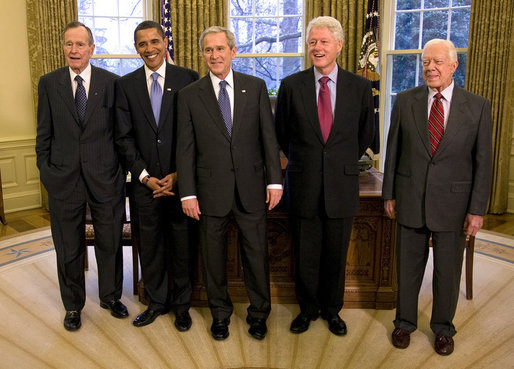In honor of President’s Day, we decided to take a look back at where our past Presidents have stood on the toxic chemical issue.
In some ways, each President in recent decades has taken steps to inch us closer to safer chemicals and healthy families, but as we all know, so much work is to be done.
Environmental Protection Agency (EPA) Created
1970 – President Richard Nixon
The Environmental Protection Agency (EPA) was established under President Nixon. In the heat of the environmental movement of the 1970s, President Nixon responded to concerns about dirty air and water and created an agency to oversee the health of the environment and subsequently our people. Upon establishing this new government agency, they promoted its creation with the Docuamerica project. This photography series captured environment issues all across America.
“By conscious choice, [we] transform our land into what we want it to become”
-President Richard Nixon
Congress passed the Occupational and Safety Health Act in 1970 to protect workers and ensure the safe workplaces. The goal was to create workplaces free of safety and health hazards, including toxic chemicals.
There is much work to be done on increasing safeguards for our workers under OSHA, and our labor partners are actively engaged in this ongoing fight for safe and secure jobs.
Toxic Substances Control Act signed into law
1976 – President Gerald Ford
Our nation’s primary law on toxic chemicals, the Toxic Substances Control Act (TSCA) was passed in 1976 under President Gerald Ford. This bill was passed along with other national environmental laws, like the Clean Air Act and Clean Water Act.
Everyone, including the chemical industry, agrees that TSCA needs to be reformed to adequately live up to its promise. As you can see from President Ford’s quote below, the promise for TSCA was great, but has unfortunately been regarded as one of the biggest failures in environmental policy.
‘This toxic substances control legislation provides broad authority to regulate any of the tens of thousands of chemicals in commerce…If a chemical is found to present a danger to health or the environment, appropriate regulatory action can be taken before it is too late to undo the damage.” – Gerald Ford
If only that were true.
Emergency Financial Aid used to help Love Canal
1978 – President Jimmy Carter
One of our coalition partners and movement leaders, Lois Gibbs, led grassroots movement to pass legislation to remediate and identify toxic waste sites in the United States. Gibbs lived in the New York community called, Love Canal, which was built on top of 20,000 pounds of toxic chemicals.
Once the chemicals began leeching through the soil and into homes and a public school, Love Canal became the Love Canal Tragedy. President Jimmy Carter approved emergency financial aid for the Love Canal area. This was the first time emergency funds were used for an incident that wasn’t a natural disaster.
Superfund Program passed and signed into law
1980 – President Jimmy Carter
The Love Canal Tragedy led to the creation of the Superfund Program, with the goal of identifying and paying for the cleanup of toxic sites. President Jimmy Cater signed this legislation into law. In 2008, President Obama’s “New Energy for America” plan supported the, “reinstatement of the “Superfund” tax under the Comprehensive Environmental Response, Compensation and Liability Act (“CERCLA”) on chemical and petroleum feedstock to pay for cleanups and reinforce the “polluter pays” principle.” The program has not been updated.
Emergency Planning and Community Right to Know Act
1986 – President Ronald Regan
Building upon the concerns around Superfund sites, Congress passed the Emergency Planning and Community Right to Know Act in 1986. This bill started the Toxics Release Inventory (TRI), which has been an important program that allows the public access to toxic chemical pollution reporting from manufacturing facilities.
Building upon the concerns around Superfund sites, Congress passed the Emergency Planning and Community Right to Know Act in 1986. This bill started the Toxics Release Inventory (TRI), which has been an important program that allows the public access to toxic chemical pollution reporting from manufacturing facilities.
(Photo Credit: Gary Hershorn/Reuters/file)
Congress addresses pesticides in food
1996 – President Bill Clinton
According to the EPA the Food Quality Protection Act (FQPA) was, “the most comprehensive and historic overhaul of the nation’s pesticide and food safety laws in decades.” FQPA was adopted under President Clinton’s administration, and aimed to regulate the usage of pesticides on the food we eat. The legislation uses a chemical safety standard that is protective for infants and children; this landmark policy confirmed the risks of pesticide use human health and the environment.
First step on chemical security
2001 – President George W. Bush
After the September 11th the threat of attacks on our domestic toxic chemical storage and chemical weapons was on the forefront of the nation’s mind. The Chemical Security Act aimed to protect public health and safety from attacks made on our chemical storage facilities. The Chemical Security Act was introduced under and signed into law by President Bush. Under the bill, plants would need to submit plans to the EPA showing how they will address their “vulnerabilities” from storing toxic chemicals.
Executive Order on chemical security
2013 – President Barack Obama
President Obama’s executive order in August of 2013, built on the Chemical Security Act. The executive order responds to the risks of toxic chemical facilities, their safety threats to workers and the surrounding communities.
After the September 11th the threat of attacks on our domestic toxic chemical storage and chemical weapons was on the forefront of the nation’s mind. The Chemical Security Act aimed to protect public health and safety from attacks made on our chemical storage facilities. The Chemical Security Act was introduced under and signed into law by President Bush. Under the bill, plants would need to submit plans to the EPA showing how they will address their “vulnerabilities” from storing toxic chemicals.
Executive Order on chemical security
2013 – President Barack Obama
President Obama’s executive order in August of 2013, built on the Chemical Security Act. The executive order responds to the risks of toxic chemical facilities, their safety threats to workers and the surrounding communities.
“We can take some common steps now to improve safety and security and build on federal agencies’ ongoing work to reduce the risks associated with hazardous chemicals.” – White House Statement
In recent years there has been great leadership from Lisa Jackson and now standing EPA Administrator Gina McCarthy for reforming our federal laws on toxic chemicals.

More steps needed to protect the public from toxic chemicals
President Obama’s Executive Order on Improving Chemical Facility and Security was a glimmer of hope for those of us working on strong laws on toxic chemicals. The steps listed above should be celebrated as successes, but more work needs to be done.
Because of the failures of our federal chemical law (TSCA), the EPA still can’t regulate asbestos. Nearly every pregnant women in the United States contains several known toxic chemicals in her body. Our workers and communities are regularly exposed to toxic chemical pollution from their community and the products we use.
The problem is widespread and requires robust solutions.
Three pronged approach
State legislators have been taking the lead on passing state level laws on toxic chemicals. This momentum at the state level has created a patchwork quilt of regulations that are both a sign of progress and point to the need for a strong federal system.
Last year we launched our Mind the Store campaign to work with the nation’s top ten retailers on comprehensive chemical policies in their stores. So far, we’ve had some initial success and engagement from retailers that indicates the market will continue to change in drastic ways.
But until we have real reform of our federal toxic chemical laws, we’ll be stuck on this toxic treadmill. We need strong federal laws on toxic chemicals.
While we look back to history it’s important to learn from the mistakes that were made. In 1976 the public thought we “took care” of toxic chemicals by passing the Toxic Substances Control Act. Congress passed a deeply flawed bill that did very little to safeguard our health and environment.
Let us remember that mistake as we move forward on federal reforms of our toxic chemical laws. At the end of the day we need a multi-pronged solution and federal reform must be real.
(Photos of Presidents from Wikimedia Commons)




